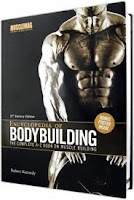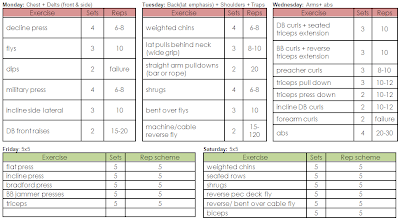 |
| Image 1: Simply copying Arnold's routine would probably be a bad idea, but copying the way he played with workload and density to achieve maximal intensity would be. |
- how often and on which days you train (cf. part I), and
- what type of workout you perform on a given day (cf. part II)
The logical next step: Set and rep prescriptions for your workouts
It goes without saying certain decisions you may have made in the last week will make at least part of the considerations regarding the total number of sets, the number of repetitions per set, the time-under-tension (TUT), the rest times between sets and many of the related, less important parameters obsolete. If, for example, you decided on a similar routine as Adelfo's week 1 EDT + 5x5 combo, you would not have to care about either the number of sets or reps, because both "workouts" (in this case the term refers to a the whole concept) include detailed prescriptions, i.e.
- "perform your superset for 20min with as many reps as you can" (EDT), and
- "do 5 sets of 5 reps to failure" (5x5)
Learning from the bros and checking with the pros
I guess, many of you will already be familiar with the most commonly cited principles of workout programing and in case you were expecting me to come up with revolutionary insights into what you may call the "workout 101", you have obviously overlooked that they were and still are the ones 90% of the successful weight lifters and bodybuilders adhere to.
- in and out of the gym in <60min
- less than 18-20 sets total
- 10-15 sets for the back and leg muscles*
- 6-9 sets for chest and shoulders*
- 4-8 sets for arms*
*the numbers apply to bodypart split training
- 3-5 reps for strength
- 6-12 reps for hypertrophy
- 12-25 reps for strength endurance (+conditioning)
And as awkward as it may seem, my personal experience tells me that in 75% of the cases, where trainees are not satisfied with the results their workout programs are generating, the underlying reasons is not following the rules. In that, I have found that the "in and out of the gym in <60min" rule and the "less than 18-20 sets total" rule, as well as the "6-9 set for chest and arms" and "4-8 sets for arms" rules appear to be among the favorite "does not apply to me" rules for the average trainee
Pull the trigger and leave!
The reason for the widespread ignorance towards these rules is the very human misconception that more was always better. To understand why this is not the case, it may be useful to read up on the underlying physiological processes of skeletal muscle hypertrophy and increases in contractile force in the respective parts of the Intermittent Thoughts on Building Muscle series, here at the SuppVersity.
 |
| Figure 1: The intricacies of skeletal muscle hypertrophy. For all the details check out the preliminary summary of the Intermittent Thoughts on Building Muscle (click here to be redirected) |
The primacy of intensity and how it relates to workload and density
Of the many factors which will determine how "long" it will take to initiate this cascade, the training workload (often also referred to as "volume"), the density and the intensity are not only the most important ones, they are also the ones you can deliberately control. "Optimal" results thusly requite that you align these factors with the ones you cannot manipulate directly, such as your age, your overall health, your current training status, the time you have to spare, etc. to match your current goals.
- Workload: Of these three variables the training "volume" is probably the most straight forward one, as it can be measured simply by the workload. Even if you are no physicist you should be aware that the work (w) is the total amount of force applied to the weith (F = mass x acceleration) times the way (S) you are moving it (W = F x S). In other words, if you carry a 50lbs stone 100m exerting the force of F = 50lbs * 10m/s² (where 10m/s² is the acceleration due to gravity), you have performed the same amount of work as someone who carries a 5lbs stone in his pocket while walking 1km. It should be obvious that this measure alone is of little value and I do still see people training set after set, staying in the gym for 2 hours, performing twice or thrice the amount of "work" I do and still stagnate in terms of strength and size gains.
- Density: If we use the previous example of carrying a stone, and think of ten steps you take as one rep, then the density of your "workout", i.e. carrying the 50lbs stone for 100m would be 10x higher than the one of the other person, because - if we assume that you walk at the same pace - you will be ready in 10x shorter timespan than the person who carries the 5lbs stone for 1000m.
- Intensity: Contrary to what you often see in the "intensity" column of many workout programs, the weight (often expressed relative to your one-repetition max, the 1RM; or as the maximal amount of weight you can lift for X repetitions, the 12RM, 6RM, etc.) is not the single determinant of the intensity of your workouts. A workout with little to no rest periods, light weights, high reps and a medium amount of sets can be as "intense" as one of Metzner's HIT workouts where you warm up for two sets perform one all out set and head home.
 |
| Image 3: German Olympic lifter Julia Rohde - do you still believe lifting heavy will make you "bulky"? (img sportzentrum-flora.de) |
Science says: Many roads lead to Rome
With "intensity" being a prerequisite and goal-specificity (re-)emerges as the fundamental determinant particularly in view of the number of reps and sets to perform. Against that background it is also less confusing that you will find scientific evidence to support almost every of the initially mentioned pieces of common wisdom. In 1999, for example, Weiss et al. confirmed the common wisdom that a low (=4x 3-5RM) rep-scheme produces favorable increases in squat performance (strength) compared to 4x 13-15RM or 4x 23-25RM routines. Now, was this a result of the heavier weight alone? No, it was the mere consequence of the specificity of the program - after all, the performance on slowly performed leg-extensions was slow-velocity (~1-2s concentric and 1-2s eccentric phase) was maximal in the 13-15RM group (Weiss. 1999).










































